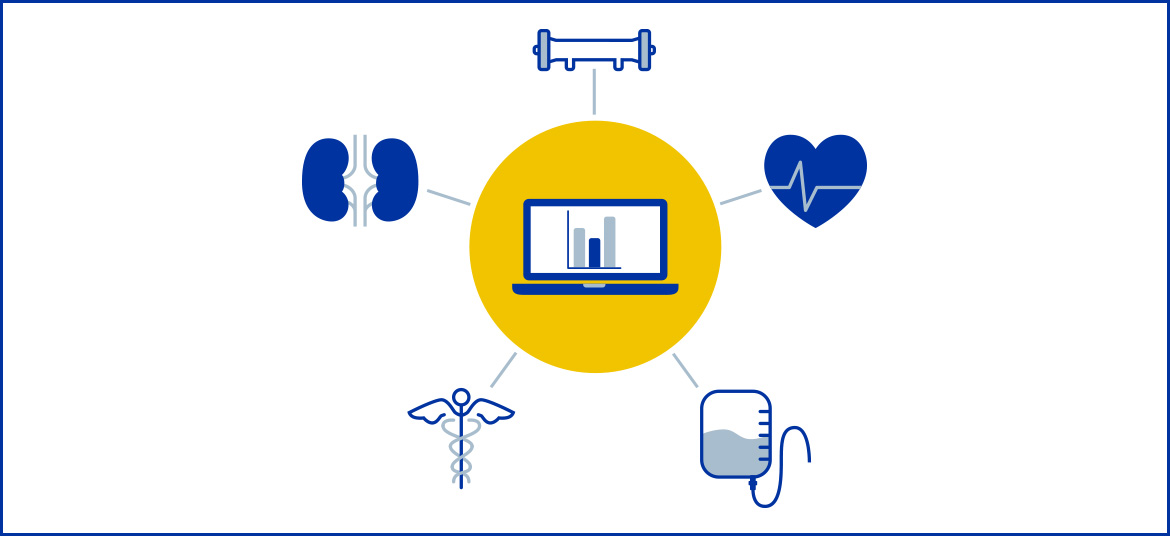
How Predictive Modeling in Healthcare Can Improve Kidney Disease Patient Outcomes
Predictive modeling in healthcare is a form of artificial intelligence (AI) that compiles data, processes information, and applies machine learning techniques to determine potential patient outcomes. These advanced tools are particularly well suited for chronic kidney disease (CKD) due to the vast amount of information collected through regular care. Vitals, acuity, comorbidities, and other routinely obtained data are used to build increasingly robust predictive tools. In value based care models, providers and payors use this information to detect and mitigate health risks, decrease hospitalizations, and improve outcomes — all while reducing costs.
Predictive Models Identify Trends in Health Outcomes
Predictive models comb through thousands of data points to determine various outcomes. The measured variables can range from well-known risk factors and complications of CKD (blood pressure or albumin, for example) to seemingly unrelated symptoms that arise. Through a combination of data science, epidemiology, and machine learning, predictive models zero in on a patient’s most probable health outcome to streamline treatment.
Predictive Models Help Keep CKD Patients Healthier for Longer
In combination with a clinician’s expertise, implementing a focused chronic kidney disease predictive model can make a significant difference in patient health. AI can anticipate fluid overload, for example, or estimate the likelihood of infection-related hospitalizations. Clinicians can also use predictive models to measure the severity of CKD and identify patients at high risk of progressing to end stage renal disease (ESRD). This information provides an opportunity to step in and help slow disease progression.
In a busy clinic setting or urgent situation, minor health changes might go unnoticed, but predictive modeling picks up on these patterns quickly. This saves physicians valuable time and effort when it counts, giving them insight and an opportunity to take action earlier. This can prevent crashing and allows physicians to manage progressive conditions more efficiently.
Beyond disease intervention, CKD predictive models can help improve quality of life. Many patients thrive on home dialysis modalities, and predictive models can identify which in-center dialysis patients may be successful at home.
AI Forecasts Outcomes in Many Facets of Healthcare
Predictive modeling in healthcare has a plethora of uses outside of CKD and ESRD management. AI is frequently used to identify the most at-risk patients, predict hospitalizations, minimize readmissions, detect disease outbreaks, streamline diagnoses, interpret imaging, and much more. Payors, including health insurance companies, often use predictive models to moderate risk and understand patient health.
When monitoring CKD and ESRD patients, the constant stream of data gives the unique opportunity to study more than just the presenting disease. Predictive models detect subtle changes in patient health — this includes dozens of variables ranging from body temperature to heart rate — and flag dialysis patients who may have COVID-19 before they start showing symptoms.
Data Analysis Supports a Value Based Care Model
AI and predictive modeling align well with value based care — that is, incentivizing quality healthcare that focuses on improving patient outcomes. Innovative techniques inspire forward-thinking disease treatment, as opposed to addressing symptoms as they arise. Providers using these tools can deliver more efficient treatments, which ultimately improves outcomes and reduces costs.
Unnecessary hospitalizations are one of the biggest drivers of higher cost to the healthcare system. Employing targeted CKD predictive modeling helps promote timely treatment and avoid hospitalization. This works as an effective form of risk management for patients as well as payors, providing key insight into needs before disease progression becomes costly or difficult to treat.
Leveraging Data Helps Provide More Efficient Care
As a form of machine learning, predictive models in healthcare become more robust with use, which yields more accurate predictions and better outcomes. Although AI assets provide valuable insight into CKD, clinicians’ opinions are essential for delivering quality care. Addressing CKD through predictive modeling and value based care helps providers make the best clinical decisions at just the right moment.



